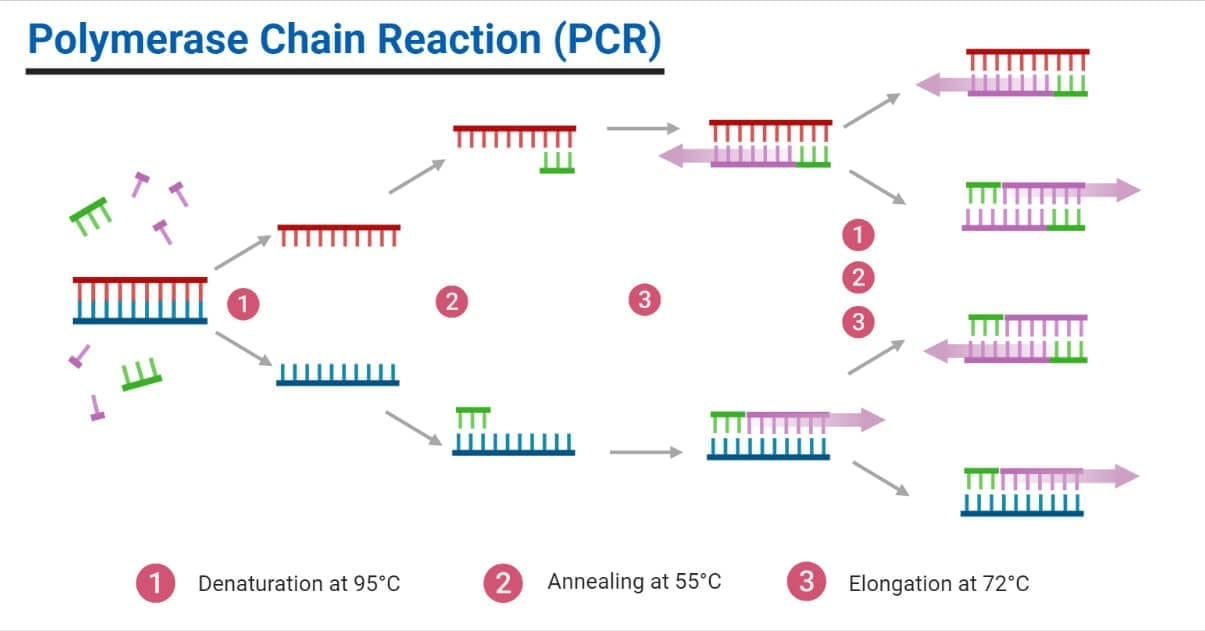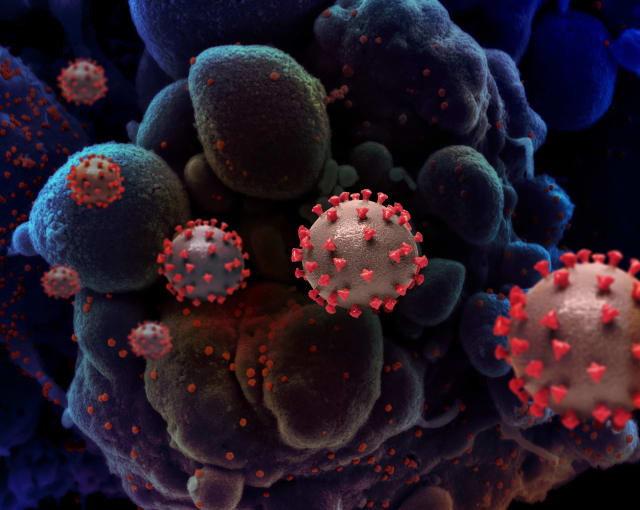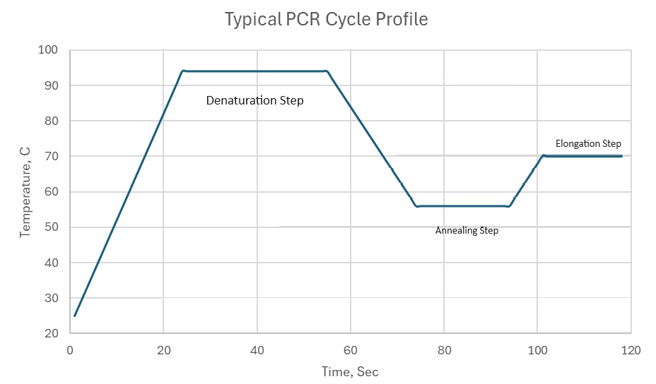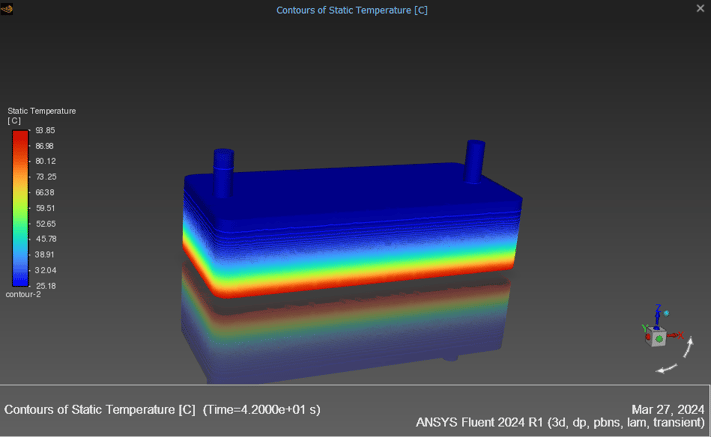Explore the revolutionary impact of Polymerase Chain Reaction (PCR) in the field of disease diagnosis.
Understanding PCR Technology
Polymerase Chain Reaction (PCR) is a powerful technique used in molecular biology to amplify a specific segment of DNA. It allows for the rapid production of millions to billions of copies of a particular DNA sample.
PCR technology involves a series of temperature cycles that enable the DNA to be denatured, annealed with primers, and extended by DNA polymerase. This process is repeated multiple times, resulting in an exponential increase in the amount of DNA. DNA polymerase is the enzyme that will enable the extension of DNA strands and the reaction is sensitive to the temperature profile. Figure 1 shows the three main stage of the polymerase chain reaction and the specific temperature that is required for each stage. Understanding the principles behind PCR technology is crucial for its successful application in disease diagnosis.

Figure 1: Different Stages of a polymerase chain reaction
PCR in Infectious Disease Diagnosis
PCR has revolutionized the field of infectious disease diagnosis. It allows for the rapid and accurate detection of pathogens, such as bacteria or viruses, by amplifying their specific DNA or RNA sequences. By targeting specific genes or regions of the pathogen's genome, PCR can identify the presence of infectious agents even at low concentrations. This has greatly improved the speed and sensitivity of diagnosing infectious diseases.
PCR-based tests have been widely used in the diagnosis of a wide range of infectious diseases, including COVID-19, influenza, HIV, tuberculosis, malaria, hepatitis, and many others. The versatility and sensitivity of PCR technology have made it a valuable tool in identifying and monitoring various pathogens, aiding in the timely treatment and management of these diseases. Its ability to detect even low concentrations of pathogens has significantly improved the accuracy and speed of disease diagnosis, ultimately leading to better patient outcomes.

Figure 2: COVID-19 Virus
PCR in Genetic Disease Diagnosis
PCR plays a crucial role in the diagnosis of genetic diseases. It allows for the detection of specific genetic mutations or variations that are associated with various genetic disorders. By amplifying and analyzing the DNA of an individual, PCR can identify genetic abnormalities that may contribute to the development of a disease. This helps in genetic counseling, early diagnosis, and personalized treatment strategies.
PCR-based genetic testing has been instrumental in diagnosing a wide range of genetic conditions, including but not limited to cystic fibrosis, sickle cell anemia, Huntington's disease, and many others. By targeting specific genetic mutations or variations, PCR technology enables healthcare professionals to identify underlying genetic causes of various disorders with high precision and accuracy. This not only aids in early diagnosis and intervention but also facilitates personalized treatment strategies tailored to individual patients' genetic makeup. The application of PCR in genetic disease diagnosis has significantly improved patient care and outcomes by providing valuable insights into the genetic factors contributing to disease development. Its role in identifying and understanding genetic disorders underscores the importance of PCR technology in advancing the field of medical genetics and personalized medicine.
Use of Thermal Modeling PCR Based Instruments
Thermal modeling is an essential aspect of PCR-based instruments. These instruments rely on precise temperature control to carry out the temperature cycles required for PCR. Thermal modeling plays a crucial role in optimizing PCR thermocycling, ensuring precise temperature control for the amplification of DNA samples. By utilizing thermal modeling and simulation techniques, researchers and manufacturers can enhance the performance of PCR instruments, leading to more accurate and reproducible results. This advancement in technology has led to the development of sophisticated PCR instruments that offer improved speed, sensitivity, and reliability in disease diagnosis. As thermal modeling continues to evolve, it will further enhance the efficiency and effectiveness of PCR technology, ultimately revolutionizing the field of disease diagnosis.
In this instance, ANSYS Fluent was utilized to simulate the temperature distribution within a basic bioreactor. As depicted in Figure 2, the PCR cycle profile evolves over time. The polymerase chain reaction undergoes 40 cycles, typically lasting around 45 minutes. The primary focus of this study was to analyze the temperature non-uniformity within the chamber, aiming to pinpoint potential design enhancements for optimizing temperature distribution. Addressing temperature non-uniformity is a key consideration in the design of PCR systems.

Figure 2: Thermal Profile for PCR Reaction
As illustrated in Figure 3, heat is conducted from the base of the reactor, resulting in a noticeable gradient in the z-direction. Interestingly, the simulation indicates that the temperature at the top of the reactor remains constant at room temperature. This intricate model serves as a valuable tool for refining the temperature distribution to achieve optimal results. Moreover, it paves the way for innovative design possibilities, such as integrating a heated top for more effective thermal management solutions. Be sure to check out the instructional video in Figure 4 for a step-by-step guide on setting up the model.

Figure 3: Transient Thermal Model for PCR Thermocycling
By using thermal modeling and simulation techniques, researchers and manufacturers can optimize the performance of PCR instruments. This helps in reducing errors, improving efficiency, and ensuring accurate and reproducible results. The use of thermal modeling has led to the development of advanced PCR instruments that offer enhanced speed, sensitivity, and reliability in disease diagnosis.
Figure 4: How to set up a transient thermal model for PCR
Future Prospects of PCR in Disease Diagnosis
The future of PCR in disease diagnosis holds immense promise as technological advancements and ongoing research efforts push the boundaries of its applications. As we look ahead, PCR is poised to redefine personalized medicine by leveraging genetic information to customize treatments tailored to each individual patient's unique genetic makeup. This personalized approach has the potential to revolutionize healthcare by maximizing treatment efficacy and minimizing adverse effects.
Moreover, PCR is anticipated to play a pivotal role in the early detection and continuous monitoring of diseases, ushering in a new era of proactive healthcare management. By enabling the rapid and accurate identification of pathogens and genetic abnormalities, PCR can empower healthcare professionals to intervene sooner, leading to improved patient outcomes and overall well-being.
The integration of PCR with cutting-edge diagnostic technologies like next-generation sequencing and microfluidics presents exciting possibilities for the future of disease diagnosis. These synergies have the potential to enhance the precision, speed, and scope of diagnostic capabilities, opening doors to novel insights and treatment strategies.
As PCR techniques continue to evolve and innovate, they are set to propel the field of disease diagnosis forward, driving progress, and shaping the future of healthcare. With each advancement, PCR solidifies its position as a cornerstone technology in the medical landscape, poised to transform the way we understand, diagnose, and treat diseases. The future of PCR is bright, promising a new era of precision medicine and improved patient care.
Apr 1, 2024 11:05:14 AM
